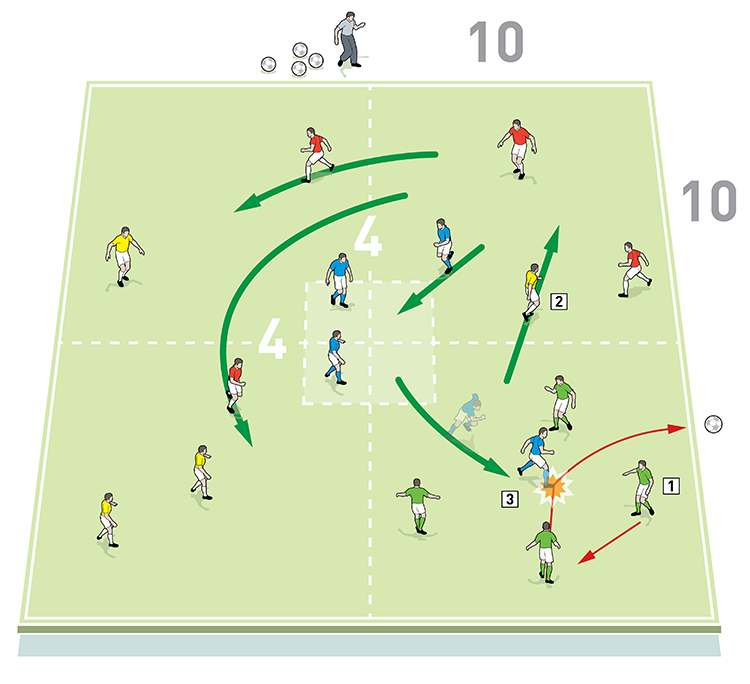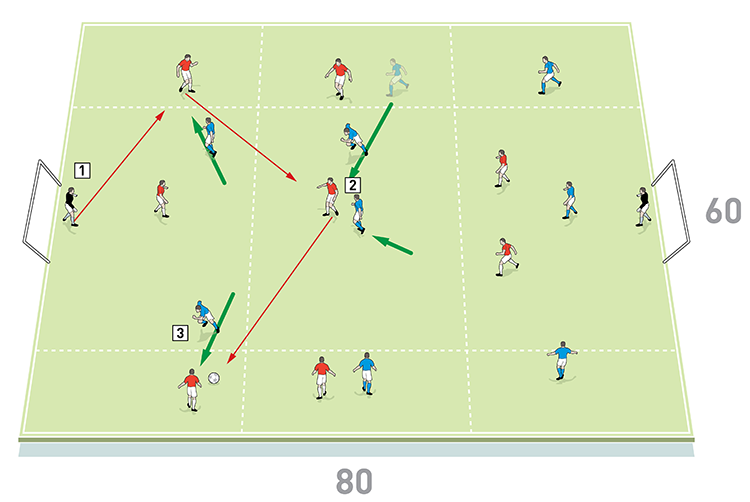You are viewing 1 of your 1 free articles
Defending principles
This session is about players developing their decision-making skills by executing our defending principles at the right times and in the right areas. It incorporates 1v1 defending, reading cues and triggers, making play predictable, and winning the ball back in the first, second or third lines.
| Area | Up to 80x60 yards |
| Equipment | Ball, bibs, cones, 2 full size goals |
| No. of Players | Up to 16 players + 2 goalkeepers |
| Session Time |
Counter-pressing rondo: 16mins, Defending transition rondo: 14mins, 9v9 game: 30mins |
This session is about players developing their decision-making skills by executing our defending principles at the right times and in the right areas. It incorporates 1v1 defending, reading cues and triggers, making play predictable, and winning the ball back in the first, second or third lines.
It is a high tempo session with constant decision-making for the players, which in turn means there will be mistakes, which makes it a great learning tool for the group. This session is adaptable to be specific enough to the opposition we are playing against, as although where and when we apply the principles may vary, the fundamentals of what we are looking to do doesn’t change.
The players enjoy this session as it keeps them constantly thinking, and it gets very competitive.
What do I get the players to do?
Counter-pressing rondo
We set up an area of 20x20 yards, made up of four 10x10-yard boxes with a smaller 4x4-yard box in the centre. We’re using 16 players split into four teams of four. One team is in the defending role in the small box, while players from the other three teams can be anywhere else in the playing area.
The coach starts play with a pass into one of the 10x10-yard boxes. All the team mates of the receiving player have to quickly move into that box to support the player on the ball, The possession team must then make four passes within that box before they can transfer the ball into another box, passing it to a player from one of the two other attacking teams. When this happens, players from the team receiving the ball must all move quickly into that square and all players from the other teams must vacate it, as shown [1a].
1a

2. Once the ball has entered a box, a defender can enter from the small central box and can try to win possession
3. The team in possession must make four passes within the box before they can transfer to another attacking player from one of the other two attacking teams
4. Once the ball is played in, all players from the receiving team have to move into the box to support player on the ball
5. When the ball transfers to a new box, all players not on the new possession team must vacate the box
Each time the ball is played into a new box, one defender can enter from the small central box and must try to win the ball back, as shown [1b]. If the ball is won by the defender, it should be cleared out of the area. A second ball is played into a different box by the coach and the game continues.
1b

2. All other attacking players vacate the box as the possession team tries to string four passes together
3. A blue defender enters the box. Here he wins possession and clears the ball out of the area. Play restarts with a pass into another box by the coach
Each team has two rotations in the defending role. We play eight 90 second games with 30 seconds of rest between games.
How do I progress the activity?
After four passes, if the team in possession doesn’t transfer the ball out of their square then another defender can enter and join their team mate in pressing. The remaining passive defenders in the small square can now try to cut out any balls close to their area.
If the defenders win the ball and can play one pass between them, they quickly swap roles with the team that gave the ball away.
What are the key things to look out for?
We want to see the correct shape of press and shadow press, plus good 1v1 defending with acceleration and deceleration. We also want to see effective passing from the possession team to ensure the defending team has to work hard to win the ball.
What do I get the players to do next?
Defending transition rondo
This is a first and second line defending transition rondo. We set up in an area of 36x25 yards divided into three 12-yard zones. We’re using 15 outfield players split into three teams of five. One team starts in each zone. The team in the central zone is always the pressing team and the teams in the two end zones must work together to keep possession and should transfer the ball across the central zone without it being intercepted. The central pressing team can send two players into the end zone to chase possession.
The team in possession must make four passes before transferring the ball to the other end zone. The ball can’t go over chest height while being transferred. The team supporting from the other end can drop into the middle box to help support play and create angles, as shown [2a].
2a

2. The team supporting possession from the other end zone can push into the central zone to help create angles to receive. Here one receives, passes to a team mate and returns to the end zone
3. The blue team in the central zone is the pressing team and they can send two players into the end zone to win the ball
4. The ball can’t go over chest height while being transferred
If the defending team wins the ball back, or if it goes out of play, they switch roles with the team that lost possession, as shown [2b].
2b

Play always restarts from the coach. We play three four-minute games with one minute’s rest in between.
How do I progress the activity?
After the possession team makes four passes, progress the activity so the defending team can send as many pressers into the end zone as they like.
To progress further, still allow the defenders to press with as many players as they need, but now take away the passing target for the possession team – they can now transfer the ball as soon as the opportunity arises.
What are the key things to look out for?
We want to see defenders closing down on the ball early and putting pressure on the possession players. We want to see effective 1v1 defending and players taking up a good shape of press to force opponents into an area for the next line to win it.
How would you put this into a game situation?
9v9 game
We set up in an area of 80x60 yards with a goal and a goalkeeper at each end. We also add zones to the pitch, as shown [3], to help the players know which area they are in and to help guide them on the pressing zones. These are for guidance only and players are not restricted to the zones.
3

2. Good team pressing by the blues forces the reds to pass the ball back and wide
3. The blues quickly press 1v1 out wide and attempt to win the ball back
We play three games of eight minutes each, with two minutes rest between games.
What are the key things to look out for?
We want to see players making good decisions on when to press and when to set the trap, based on a number of factors including the zone the ball is in. We also want to see players using what they’ve learnt in the previous activities, including good 1v1 defending and keeping an effective shape for the press to force opponents into an area for the next line to win it.
What are the typical mistakes players might make and how do I avoid them?
To make this session work properly, our possession principles must be present and the passing players should be moving the ball with quality and in the manner that the opposition will in our next game.
It’s vital that this occurs, so that the session is realistic to what the players will face on a match day and so that the speed at which the players will have to make decisions replicates a game scenario. Once this is happening, then the pictures we want to see will start to appear and we can begin to solve the problems that are likely to occur in the next match.
The reason we add in the progressions is so players don’t fall into the trap of pressing everything all of the time, because this is when they can get themselves into trouble. We speak to the players continuously about not always having to be the one who directly wins the ball, but to shape the press to help the next line – the midfield or the defence for example, so they are able to be on the front foot with their defending and step in and win the ball.
Related Files
Editor's Picks
Deep runs in the final third
Using the goalkeeper in build-up play
Pressing principles
Intensive boxes drill with goals
Penetrating the final third
Creating and finishing
My philosophy
Pressing initiation
Compact team movement
Coaches' Testimonials

Alan Pardew

Arsène Wenger

Brendan Rodgers

Carlos Carvalhal

José Mourinho

Jürgen Klopp

Pep Guardiola

Roy Hodgson

Sir Alex Ferguson

Steven Gerrard
Coaches' Testimonials

Gerald Kearney, Downtown Las Vegas Soccer Club

Paul Butler, Florida, USA

Rick Shields, Springboro, USA

Tony Green, Pierrefonds Titans, Quebec, Canada
Join the world's leading coaches and managers and discover for yourself one of the best kept secrets in coaching. No other training tool on the planet is written or read by the calibre of names you’ll find in Elite Soccer.
In a recent survey 92% of subscribers said Elite Soccer makes them more confident, 89% said it makes them a more effective coach and 91% said it makes them more inspired.
Get Monthly Inspiration
All the latest techniques and approaches
Since 2010 Elite Soccer has given subscribers exclusive insight into the training ground practices of the world’s best coaches. Published in partnership with the League Managers Association we have unparalleled access to the leading lights in the English leagues, as well as a host of international managers.
Elite Soccer exclusively features sessions written by the coaches themselves. There are no observed sessions and no sessions “in the style of”, just first-hand advice delivered direct to you from the coach.









